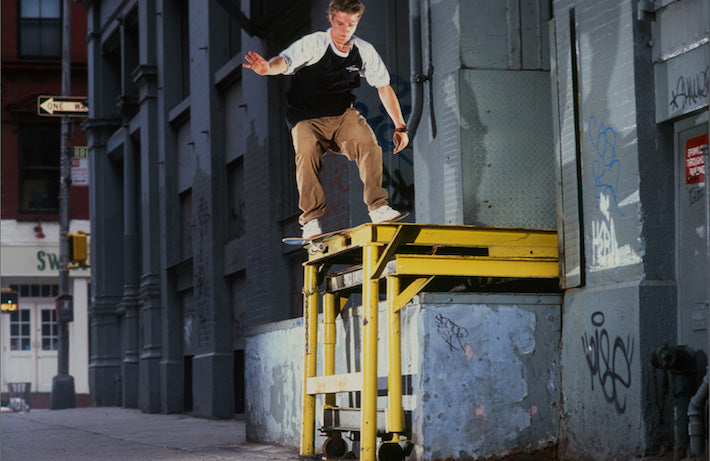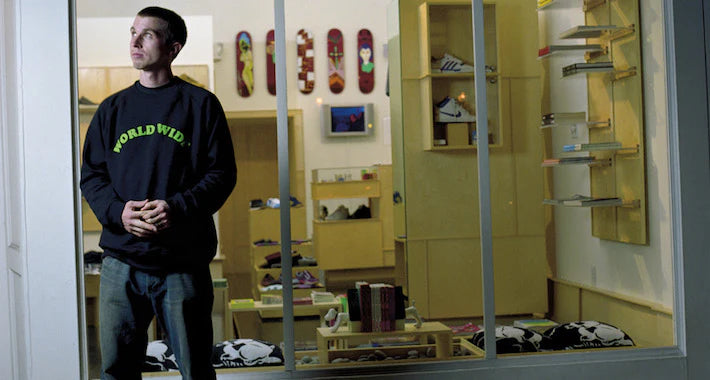Keith Hufnagel
Words by Robert Brink / Monster Children, December 2020
It always begins with skateboarding.
And when Keith Hufnagel first entered public consciousness in the early ‘90s, it was an era synonymous with the technical and the progressive. He who flipped and spun his board the most, in the baggiest, brightest clothes—no matter how ridiculously unappealing it looked—won.
But Keith skated fast. He was quick-footed. He could ollie—high, with seemingly little effort. He was pure street and he had style; quite possibly one of the first pros of a generation to show us how to truly look graceful on a skateboard when all the sloppy bells and whistles of triple kickflips and switch stance pressure flips were stripped away.
But it was never for lack of ability.
‘In the early days,’ says Gino Iannucci, who met Huf in 1990, ‘Keith was always pushing the envelope with cutting-edge tricks. He was just a natural who looked really solid on a skateboard. Then he brought the East Coast to California and showed the West Coast what was up. That was an important thing, especially back in the day. He was a New Yorker in San Francisco.’
Huf rose to prominence with a relatively small arsenal of ‘basic’ tricks. When we think of Huf, we think of the ollie. We think of that push and the way his hands casually floated down by his sides, dangling slightly behind him, palms facing backwards. We think of lipslides and backside flips and 360 flips. We think of the frontside noseslide on the October 1993 cover of TransWorld SKATEboarding and the midtown Manhattan marble he did it on, subsequently named, and forever to be known as, ‘The Huf Ledge.’
Every skate spot in the world has a name, but very few are named after a pro skater.
Keith skated with simplicity, power and a restraint unlike most of the pros of the time—and gaining the skate world’s attention in such a manner was a near-impossible feat. Huf’s skateboarding was the by-product of good taste and class, and he maintained prominence and respect for the duration of his pro career with Real Skateboards (as well as Thunder and Spitfire) for more than a quarter of a century—which puts him in another unique category: Keith was one of very few, if not the only skater next to Steve Caballero to stay continuously with his sponsors for more than twenty-five years.
In addition to helping put Real on the map, Keith elevated DC Shoes to the top of the footwear heap as part of their legendary ‘second squad.’ He then migrated to DVS and did the same, earning himself a pro model shoe in the days when pro shoes mattered.
Unlike, say, the Chad Muskas, Jamie Thomas’ and Bam Margeras of the mid-to-late ‘90s, who exploded onto the scene, resulting in near-exhausting media blitzkriegs, Huf’s peak years as a pro and presence in magazines and videos was well-paced, humble and understated—never brazen; never overdone. Quality over quantity, with just enough to leave you wanting more.
That was because, like many of us, Keith’s skateboarding was reflective of his personality.
‘Keith was a quiet dude,’ says photographer and friend Giovanni Reda. ‘Some people, like me, have a big fuckin’ mouth and they’re yelling and screaming and carrying on and telling jokes, but when Keith finally had something to say, it was always fucking important.’
Most young skateboarders will never get sponsored. Less will go on to become pro. Even less than that will get a signature shoe, and fewer still will have a spot named after them or stay with their sponsors for twenty-five years or more.
As a skateboarder, Huf achieved dreams that millions never will. He did the impossible many times over—and that’s only half the journey.
So, imagine all of the above, but then, because your drive and dynamic personality thrive on challenge and you yearn for more than just skateboarding, you open a store in San Francisco named after yourself, with your then-wife and all the money you have in the bank. Selling all the coolest, rarest sneakers and even helping design some with other brands to be sold in your store.
Then, imagine by some miracle, it works. So, you open three more stores in the city, and another in Los Angeles, while maintaining a professional skateboarding career.
Then, imagine the HUF-branded clothing you’ve been making for your stores is so popular that it evolves into a full-fledged apparel brand.
Then, the opportunity arises to start a footwear brand with a team of some of the most talented and stylish skaters of the times and everything you built crosses over into mainstream culture, globally, without you losing a shred of respect from the über-critical and quick-to-dismiss-anyone-who-doesn’t-follow-the-rules skateboarding community.
Then, as this unfathomable empire continues to grow, you open multiple stores in Japan and one back home in New York.
Imagine you did all this before you turned forty.
And six years later, after a two-and-a-half-year battle with brain cancer finally has its way with you, a narrative beyond that of the magical, one-of-a-kind skateboarding and entrepreneurial legacy you left behind arises, as all the people who you touched begin to speak out and pay their respects—and that narrative is not about the big ollies or the weed socks or millions of dollars but, rather, the story of your character:
‘Keith had our backs,’ says artist Todd Francis. ‘He supported so many of us artists, photographers, musicians, creatives. He understood how challenging it is for us to make a living, and he looked out for a great many nutjobs like me, Porous Walker, Haroshi, Sean Cliver, Hanni El Khatib, Giovanni Reda and so many more. If Huf believed in your work, he would back you hard.’
‘Keith used his power and generosity, always, to lift others up. Unconditionally and with grace. That’s how I’ll remember him,’ says HUF brand copywriter, Cody Koester.
‘Keith made people better,’ says longtime friend Ray Mate’. ‘He was great at working with people and enhancing their creative flow. He genuinely helped lots of people and it all came back to him because Huf was kind.’
‘Keith wasn’t the best skater and people knew that,’ says former HUF pro Austyn Gillette. ‘But he was as good at what he did, and it was highly revered—never lacklustre. Keith always made time for you too, and that was important. He’d rather set up a day to meet than be like, “Hey, come into the office, I’m busy but I’ll see you for five minutes.”’
‘But the most inspiring thing,’ Austyn continues, ‘was seeing him make his own world and seeing the empire he created in only ten years. Huf built something special that supported a lot of people. He gave back to the industry that supported him and did it with a lot of integrity, but you could tell he had a lot of fun with it too. He created a world for other people. He left us with that cascading effect.’
‘When the books are written,’ says Jim Thiebaud, Vice President of Deluxe, ‘when people talk about who did it fucking rad, Keith’s name is going to be at the top of the list.’
‘When I met Keith,’ says Anne Freeman, Keith’s former business partner and ex-wife, ‘I instantly recognized a few things that were so different from anybody else I’d ever encountered in skateboarding. He had quiet strength. His presence commanded the room without ever having to speak. He was incredibly kind in an authentic, meaningful way. Keith would engage with anyone and he looked you in the eye when you spoke to him—he listened to what you had to say. That is rare and that touches people.’

‘Keith had a work ethic beyond anybody I’ve ever met,’ Freeman continues. ‘No job was beneath him. He did whatever needed to be done with humility and appreciation for the simple fact that he had the opportunity to do it. He packed more into a day than anyone. He’s an easy person to root for because you want the kindest people to achieve all the things they want in life, so he got that support. Everybody that Huf hired loved to work for him because he wasn’t a boss, he was a leader by showing how it’s done.’
‘You look at Keith and you’re looking at twenty lifetimes’ worth of experiences, achievements and goals that were exceeded beyond even his wildest dreams,’ Freeman adds. ‘Keith just met every single challenge by taking a deep breath and saying, “Okay, this can be done. How do I do it?”’
